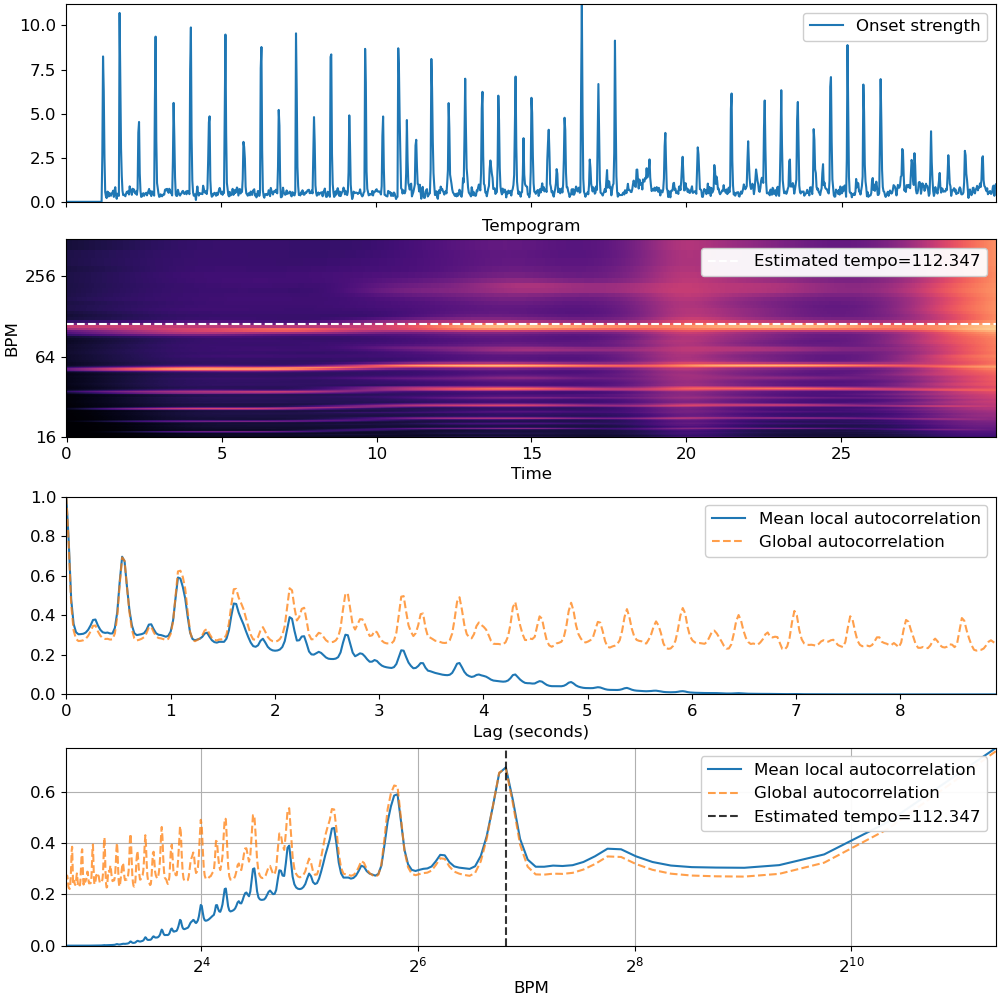librosa.feature.tempogram
- librosa.feature.tempogram(*, y=None, sr=22050, onset_envelope=None, hop_length=512, win_length=384, center=True, window='hann', norm=inf)[source]
Compute the tempogram: local autocorrelation of the onset strength envelope. [1]
- Parameters:
- ynp.ndarray [shape=(…, n)] or None
Audio time series. Multi-channel is supported.
- srnumber > 0 [scalar]
sampling rate of
y- onset_envelopenp.ndarray [shape=(…, n) or (…, m, n)] or None
Optional pre-computed onset strength envelope as provided by
librosa.onset.onset_strength.If multi-dimensional, tempograms are computed independently for each band (first dimension).
- hop_lengthint > 0
number of audio samples between successive onset measurements
- win_lengthint > 0
length of the onset autocorrelation window (in frames/onset measurements) The default settings (384) corresponds to
384 * hop_length / sr ~= 8.9s.- centerbool
If True, onset autocorrelation windows are centered. If False, windows are left-aligned.
- windowstring, function, number, tuple, or np.ndarray [shape=(win_length,)]
A window specification as in stft.
- norm{np.inf, -np.inf, 0, float > 0, None}
Normalization mode. Set to None to disable normalization.
- Returns:
- tempogramnp.ndarray [shape=(…, win_length, n)]
Localized autocorrelation of the onset strength envelope.
If given multi-band input (
onset_envelope.shape==(m,n)) thentempogram[i]is the tempogram ofonset_envelope[i].
- Raises:
- ParameterError
if neither
ynoronset_envelopeare providedif
win_length < 1
Examples
>>> # Compute local onset autocorrelation >>> y, sr = librosa.load(librosa.ex('nutcracker'), duration=30) >>> hop_length = 512 >>> oenv = librosa.onset.onset_strength(y=y, sr=sr, hop_length=hop_length) >>> tempogram = librosa.feature.tempogram(onset_envelope=oenv, sr=sr, ... hop_length=hop_length) >>> # Compute global onset autocorrelation >>> ac_global = librosa.autocorrelate(oenv, max_size=tempogram.shape[0]) >>> ac_global = librosa.util.normalize(ac_global) >>> # Estimate the global tempo for display purposes >>> tempo = librosa.feature.tempo(onset_envelope=oenv, sr=sr, ... hop_length=hop_length)[0]
>>> import matplotlib.pyplot as plt >>> fig, ax = plt.subplots(nrows=4, figsize=(10, 10)) >>> times = librosa.times_like(oenv, sr=sr, hop_length=hop_length) >>> ax[0].plot(times, oenv, label='Onset strength') >>> ax[0].label_outer() >>> ax[0].legend(frameon=True) >>> librosa.display.specshow(tempogram, sr=sr, hop_length=hop_length, >>> x_axis='time', y_axis='tempo', cmap='magma', ... ax=ax[1]) >>> ax[1].axhline(tempo, color='w', linestyle='--', alpha=1, ... label='Estimated tempo={:g}'.format(tempo)) >>> ax[1].legend(loc='upper right') >>> ax[1].set(title='Tempogram') >>> x = np.linspace(0, tempogram.shape[0] * float(hop_length) / sr, ... num=tempogram.shape[0]) >>> ax[2].plot(x, np.mean(tempogram, axis=1), label='Mean local autocorrelation') >>> ax[2].plot(x, ac_global, '--', alpha=0.75, label='Global autocorrelation') >>> ax[2].set(xlabel='Lag (seconds)') >>> ax[2].legend(frameon=True) >>> freqs = librosa.tempo_frequencies(tempogram.shape[0], hop_length=hop_length, sr=sr) >>> ax[3].semilogx(freqs[1:], np.mean(tempogram[1:], axis=1), ... label='Mean local autocorrelation', base=2) >>> ax[3].semilogx(freqs[1:], ac_global[1:], '--', alpha=0.75, ... label='Global autocorrelation', base=2) >>> ax[3].axvline(tempo, color='black', linestyle='--', alpha=.8, ... label='Estimated tempo={:g}'.format(tempo)) >>> ax[3].legend(frameon=True) >>> ax[3].set(xlabel='BPM') >>> ax[3].grid(True)
